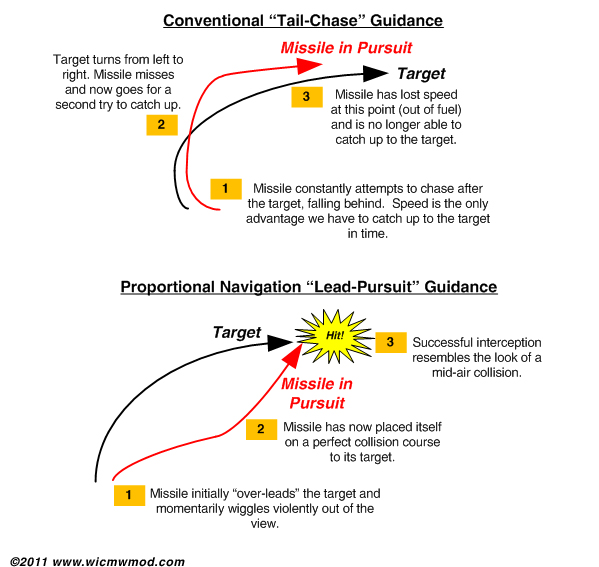I have been seeing (and feeling) the pain of streak ssrms for quite some time and have head many call for balance; usually in the form of damage reduction or target lock increases.
Although these ideas would certainly reduce the effectiveness of streaks, they would still be criticized as "win buttons" that require no skill to shoot and don't allow for any sort of dodge since they always hit.
This may be canon, but doesn't translate well in a video game.
I would argue that the problem isn't damage or lock time. It is due to the fact that these missiles move too fast and have an astounding turn radius. Everyone has seen a raven point the other way and drop a couple of streaks into your side.
An increase in turn radius and perhaps even a reduction in speed would be great, except that now then none of the streaks could hit anything traveling faster than a heavy. This is because the current streaks use pure pursuit guidance.
Here is a quick video showing what I mean:
See how the missiles have to curve more and more to keep up with the mech? (I also suspect the reason for the crazy ragdoll to be caused by the extreme acceleration of the streaks as they change direction)
This is because the streaks point at a mech, not where it is going to be. After every time step the missile makes a course correction to point at the target again.
Here is a picture of what I mean, illustrated by the almighty blahdy:
Now what you are seeing in the second half of that picture is lead pursuit guidance, also known a proportional navigation. Missiles point where the target is going, not where the target currently is. It would be like shooting without leading your target.
As you can see in the diagram, most missiles only violently maneuver during the first fraction of a second. Afterward. their ability to change course is limited. If we had something like this modeled in-game, I would probably make the maneuverability of the missile a function of time, dropping off after the first quarter second.
It is true that it would probably easiest to implement with the velocity vector and the distance from the missile to the mech then solve for a vector that forms a right triangle with a bit of integration. But that is probably too taxing on both the cpu and that poor dev who will have to break out the old calculus textbook again. Instead, you could use an algorithm similar to what is used in real life:
Find the angle and angular velocity of the target. If the angular velocity is positive, mirror the angle of the mech across the missile's Z axis. If not, use your original angle. Then, instead of pointing the nose directly at the mech, attempt to maintain this new angle with the mech. Assuming that the target is less than 90 degrees from the Z axis the missile will be on a collision course with it's target.
I know what your thinking: "This is battletech! We don't need realistic missiles. We drive walking tanks!"
But it has a benefit that, in my opinion, outweigh it's slightly greater complexity. This firing solution has a limit. If you make a sharp turn in the opposite direction or use jumpjets to suddenly accelerate, the missile will already be committed to a course that is too far off for it to correct. This would allow a skilled light pilot to break lock by outmaneuvering the missile. This would prevent the instant death that commandos and spiders face while keeping the streaks a real threat for the heavier and less maneuverable mechs.
If you guys are more interested in what proportional navigation in a video game looks like check out the World in Conflict Modern Warfare Mod. Their FLINT navigation system is superb and they were the first to introduce me to proportional navigation.
Pretty much everything here was taken from their blog post from a while back.
They also have some cool videos (and dubious music choices) on their youtube channel
Edited by Hobietime, 23 January 2013 - 11:27 AM.

























